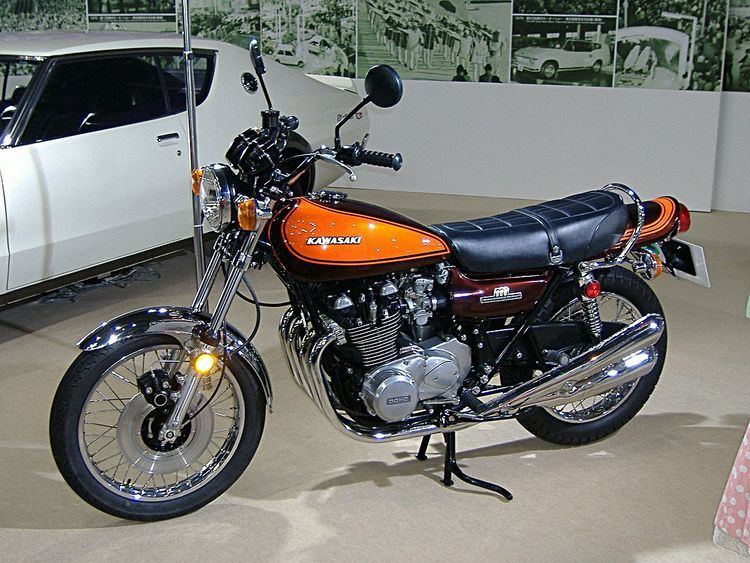Successor Kawasaki Z900 | Class Standard (muscle bike) | |
 | ||
Manufacturer Kawasaki Heavy Industries, Ltd. Also called Kawasaki 900 Super Four Production 1972—1975; 85,000 units (est.) Engine DOHC 903 cm (55.1 cu in) air-cooled, inline-four | ||
The Kawasaki Z1 is a four-cylinder, air-cooled, carbureted, chain-drive, two passenger motorcycle introduced in 1972 by Kawasaki. Following Honda's 1969 CB750, the Z1 helped popularize the in-line, cross-frame four-cylinder a format that became well known as the Universal Japanese Motorcycle or UJM.
Contents
The Z1 was noted for combining elements available previously on numerous motorcycles, into a single motorcycle.
Marketed variously as the Z900, 900 Z1 or 900 S4 ("Super Four"), the Z1 was the first of Kawasaki's Z models.
History
The Kawasaki Z1 was developed under the project name "New York Steak". In the late 1960s Kawasaki, already an established manufacturer of two-stroke motorcycles, had begun prototyping a 750 cc four-cylinder four-stroke sports motorcycle working with McFarlane Design in 1969 to develop the bikes overall appearance. When Honda introduced the CB750 to the market first, Kawasaki postponed the Z1's release until its displacement could be increased to 903 cc and the motorcycle could be marketed in the 1000cc-class.
Z1 production began in 1972 as the most powerful Japanese 4-cylinder 4-stroke ever marketed. In 1972 the Z1 set the world FIM and AMA record for 24-hour endurance. Beating the old record by 19.54 mph at Daytona for 2,631 miles with an average speed of 109.64 mph. Also at this time at Daytona a one-off Z1 ridden by Yvon Duhamel that was tuned by Yoshimura set a one lap record of 160.288 mph.
The Z1 featured full instrumentation and an electric start, produced 82 bhp and had a maximum speed of 130 mph to 132 mph(210 km/hr). It met with positive reviews from the motorcycle press, who praised its smoothness, damped vibration, easy-starting (kick-start and electric were both available), straight-line stability and linear acceleration. Steering was accurate and the bike handled well, but testers said the rear tire, chain and rear shocks all wore out quickly.
The Z1 was awarded the MCN 'Machine of the Year' accolade each year from 1973 to 1976 (an award resulting from a readers' opinion-poll run by UK weekly publication Motorcycle News) The Society of Automotive Engineers of Japan (Japanese) includes the 1972 Z1 as one of their 240 Landmarks of Japanese Automotive Technology.
Design changes
The basic design of the Z1 remained relatively unchanged until 1975, when the 903 cc "Z1-B" was introduced, with changes including power output, improved suspension, a stiffer frame, deleted automatic chain oiler, revised styling (essentially paint scheme and side cover nomenclature), and improved braking.
Follow-up series
In 1976 the Z1 was replaced by the Kawasaki KZ900, called Z900 in some countries. This was succeeded by the 1977 Kawasaki Kz1000 ("Z1000") and Kawasaki Z1000 Z1-R, and in 1984 by the Kawasaki Z1100R.
In 1983, Kawasaki won back the crown of the fastest production bike with the Kawasaki GPZ900R which had some other references to its predecessor like the model designation code ZX900, four cylinders and 900 ccm.
The 1991 Kawasaki Zephyr series copied a lot of the design of the first naked Z1, as did the Z1000 in 2003. It received updates in 2007 and a major redesign in 2010.
